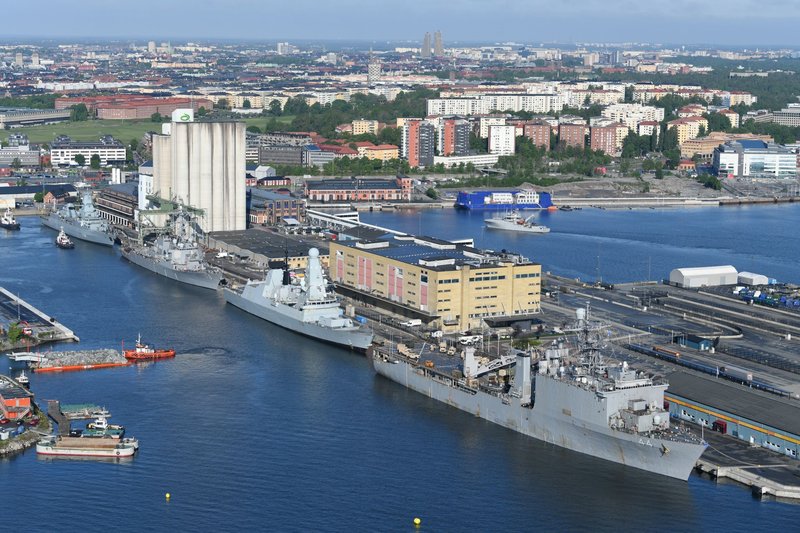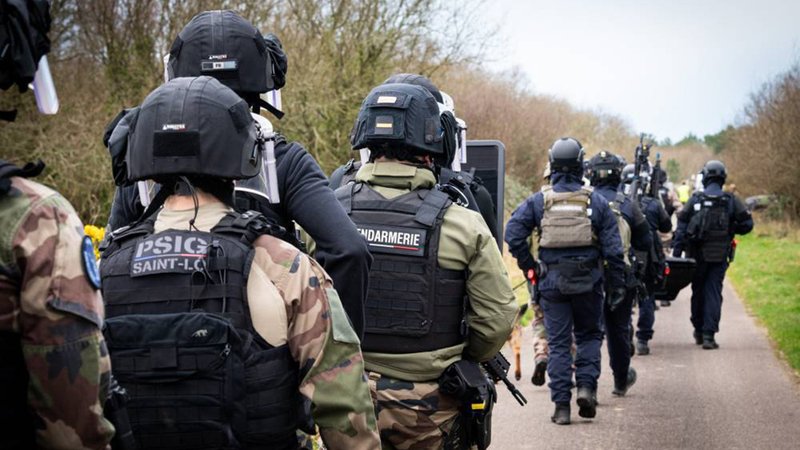Is nowhere safe? Countering the threat to naval vessels at their home ports
Naval base protection may not often make the headlines, but as Ukraine’s attacks on Russia’s Black Sea facilities demonstrate, it is indispensable. From forcing an opponent to rethink their fleet distribution strategy to holding the potential of being a conflict-changer, how navies protect their bases is a critical matter that deserves far more attention than it currently gets.
Over the course of two years, since Russia’s invasion of Ukraine, the former’s Sevastopol naval base has been targeted several times by its opponent... Continues below
Newsletter Sponsor:

Above: Whether temporarily based for an exercise or at their home port, berthed naval vessels require 360-degree multi-domain protection. (Photo: USN)
Whether these attacks succeeded in inflicting serious damage to Moscow’s naval assets is almost beside the point. What matters most, in fact, is that Ukraine has successfully managed to make the Russian Navy feel unsafe in its own base.
Images and reports circulating on social media show that over the past year Russia has been adding multiple layers of defence to protect Sevastopol. From intensifying patrols – with boats, helicopters and even trained dolphins – to floating booms and nets, the Russian fleet has been trying hard to feel safe at home again.
Yet at the end of 2023 multiple news sources reported that Russia was contemplating building new Black Sea ports in the breakaway Abkhazia region of Georgia. It was also reported that Moscow was thinking of moving some key naval capabilities in potentially safer ports, Novorossiysk and Feodosia.

Schiebel – leading the unmanned evolution
In other words, with its uncrewed systems attacks, Ukraine has forced the Russian Navy into a very uncomfortable position, one that requires it to rethink critical elements of its Black Sea strategy. That is how important naval base protection is.
But this issue is complex. Apologies to anyone from the land or air forces reading this, but navies, frankly, have the toughest job when it comes to protecting their own assets. Threats can come from land, air, on the water or below the surface – it requires a full 360° three-dimensional approach.
Naval base protection starts, undoubtedly, by layering multiple defence systems covering all dimensions.
Companies like Sonardyne know this well and have made it their business to provide an array of solutions that can help protect against multiple threats.
It offers systems like the Sentinel Intruder Detection Sonar that help detect, track and classify divers and UUVs approaching protected high-value assets. Image Soft provides similar solutions to prevent intrusion, and these systems are typically augmented by powerful algorithms that enable the decluttering of data gathered in complex environments, noise pollution, water quality, etc.

Above: Sonar detection systems are one of many layers in a naval base’s defensive network. (Photo: Sonardyne)
Similarly, mine countermeasure (MCM) solutions have a role in protecting naval bases and their assets. As the war in Ukraine – once again – demonstrates, minelaying is not a thing of the past, and protecting naval vessels in one’s home bases also includes ensuring that they can safely leave and return.
Finally, companies like Hensoldt provide radar solutions to protect the airspace around a naval base, which also plays a significant part. Certain types of radar may even represent a first protective layer by providing early warning. This is the case, for instance, for long-range radars capable of detecting, identifying and tracking multiple threats at sea simultaneously.
And because threats may come from within just as well as from without, smart technologies can also provide a crucial way to increase base security.
Singapore, for instance, has started a Smart Base Access project that utilises a combination of facial recognition and digital identification to simplify the process while maintaining high security standards, according to the country’s Ministry of Defence.
Other articles in this newsletter:
Hard to foresee – why predictive maintenance for naval vessels may never be comprehensive
Ready for action? Unpicking France’s plans for an armed UUV
But the best technical solutions will prove ineffective if the humans responsible for taking action are not trained to do so efficiently and effectively. Naval base protection also needs readiness.
On 15 February, the French Navy was part of an exercise practicing protected site defence around Cherbourg. This activity, carried out in collaboration with ground forces and local government, took place across multiple sites, including the city’s naval base, and integrated a wide range of threats – maritime, land, uncrewed, cyber, etc.
Civil protection agencies, such as the Gendarmerie and Police nationale, the Red Cross, firefighters and maritime safety volunteers, also participated. This broader involvement is reminiscent of Swedish Chief of Navy RAdm Ewa Skoog Haslum’s repeated assertion that defence should take a ‘whole of society’ approach.

Above: Law enforcement and local government also have a part to play in naval base protection if a ‘whole of society’ approach is adopted. (Photo: French Navy)
Finally, naval base protection – or its failure – can also have significant consequences for business transactions.
As part of the never-ending saga of Australia’s AUKUS nuclear-powered submarines, multiple reports have emerged over the past year exposing inadequate levels of security around the country’s naval bases.
Or rather, existing levels of security may suffice to protect the capabilities currently possessed during peacetime. But as regional tensions increase and as the country prepares to receive – one day – its new nuclear-powered submarines, security must be ramped up.
Nuclear propulsion is a very sensitive technology. That is why it exemplifies sovereignty and why the US has, so far, only ever shared it with one other partner. It follows that facilities hosting such technology should be rigorously protected. Yet evidence emerging from Down Under seem to indicate that hardening such facilities is currently not a priority.
Similarly, Royal Australian Navy (RAN) policing and security capabilities, local sources report, are not growing fast enough. To take an approach such as the one tested in Cherbourg by the French Navy, or adopted by the USN’s security Limited Duty Officer and Master-at-Arms communities, the RAN’s policing and security capabilities would have to grow by at least 10%. And this is just one part of the equation. Personnel also need to be vetted and adequately trained – which takes time and money.
Should the RAN not succeed in demonstrating to its AUKUS partners that it is capable of successfully securing the naval bases that will be home to future nuclear-powered submarines, who’s to say what the US and the UK will decide to do.
So… what is the status of your country’s naval base security like these days?
Don't want to miss out on future Decisive Edge content? Make sure you are signed up to our email newsletters.











